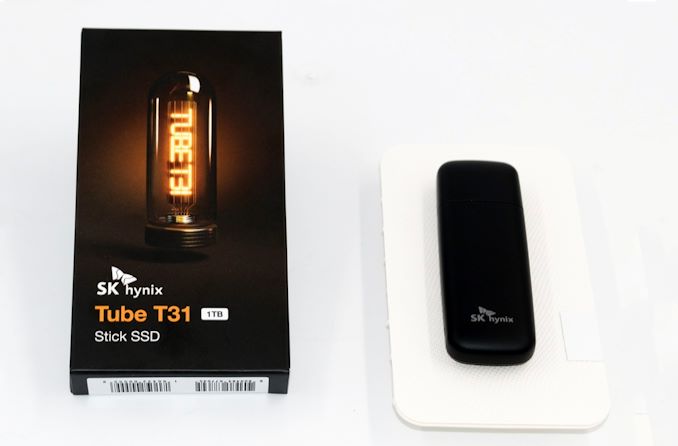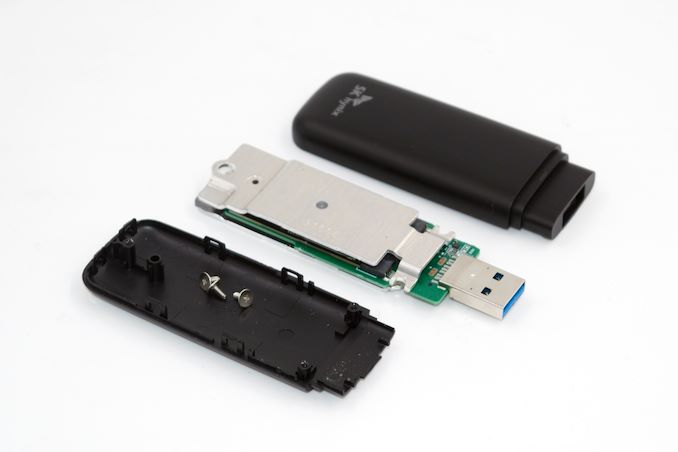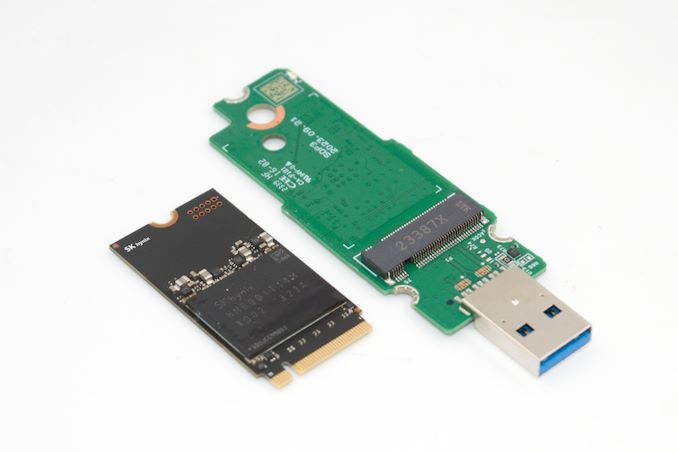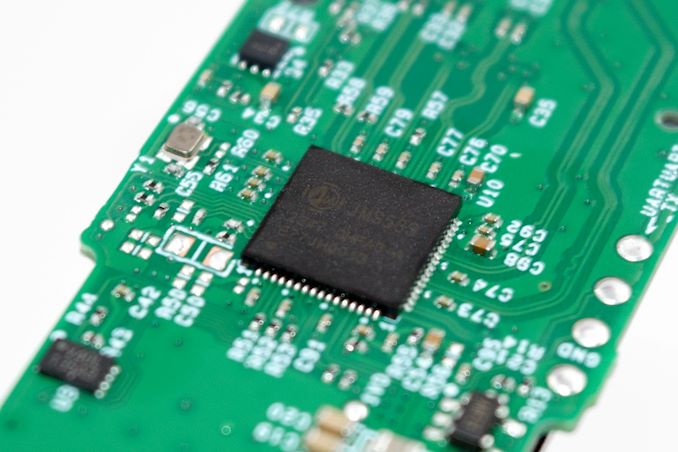SK hynix Tube T31 Stick SSD Review: Bridging Solution Springs A Surprise
by Ganesh T S on April 15, 2024 8:00 AM EST- Posted in
- Storage
- SSDs
- flash
- DAS
- JMicron
- SK Hynix
- USB 3.2 Gen 2
- Portable SSDs

SK hynix is one of the few vertically integrated manufacturers in the flash-based storage market (along with Samsung, Micron / Crucial, Western Digital, and Kioxia). The company is well-established in the OEM market. A few years back, they also started exploring direct end-user products. Internal SSDs (starting with the Gold S31 and Gold P31) were the first out of the door. Late last year, the company introduced the Beetle X31 portable SSD, its first direct-attached storage product. In February, a complementary product was introduced - the Tube T31 Stick SSD.
The Beetle X31 is a portable SSD with a Type-C upstream port and a separate cable. The Tube T31 is a take on the traditional thumb drive with a male Type-A interface. The size of the Beetle X31 makes the use of a bridge solution obvious. Our investigation into the Tube T31 also revealed the use of the same internal SSD, albeit with a different bridge. This review takes a detailed look at the Tube T31, including an analysis of its internals and evaluation of its performance consistency, power consumption, and thermal profile.
Introduction and Product Impressions
USB flash drives have grown both in storage capacity and speeds over the last few years. Thanks to the advent of 3D NAND and rapid iterations with performance improvements in the USB specifications, we are now seeing 'stick SSDs' capable of delivering 1GBps+ speeds. This market segment has slowly been gaining members since the introduction of the Kingston's DataTraveler Max in late 2021. Some stick SSD vendors have attempted to differentiate themselves by even offering 2TB SKUs.
The high-performance 'stick SSD' segment is relatively new, and has been dominated by native UFD controllers (Silicon Motion's SM2320 in products such as the Kingston DataTraveler Max A and Transcend ESD310C, and the Phison U17 in the OWC Envoy Pro Mini for example). This is in contrast to early high-performance UFDs such as the Corsair Voyager GTX and the Mushkin Ventura Ultra which employed a SATA SSD controller behind a USB 3.0 bridge. In high-performance scenarios, the bridge solution is usually avoided for UFDs due to thermal constraints. BOM cost is also another important aspect, as UFDs usually tend / need to be priced lower than portable SSDs. Factors such as the absence of a separate cable help with that, but a bridge solution in the PCB could potentially offset the savings.
The Beetle X31 from SK hynix was a traditional portable SSD that employed a SK hynix BC711 M.2 2242 NVMe SSD behind an ASMedia ASM2362 USB 3.2 Gen 2 bridge chip. Unlike other PSSD families with a wide range of capacity options, the Beetle X31 was introduced with only two capacity options - 512GB and 1TB. The reason ended up being the single-chip BC711 internal SSD - the package integrates the flash dies, SSD controller, and DRAM for the flash translation layer as well. The highly integrated nature of the BC711 ended up limiting the number of NAND dies, and hence the limited capacity options.
The Tube T31 being reviewed today also comes in the same two capacity points - 512GB and 1TB, pointing to the likely use of the same internal SSD. The integration of the flash dies and the controller in a single package alleviates some of the BOM concerns, and a bridge-based solution based on the BC711 ends up with a similar PCB area to a native UFD controller-based solution.
The Tube T31 is relatively bulky for a USB flash drive, and is bound to interfere with devices / cables connected to neighboring USB ports. However, the dimensions are unavoidable due to the use of a M.2 2242 internal SSD and its associated thermal solution. Since this is a UFD solution, the packaging is spartan - just the user manual and the main unit in an environment-friendly recyclable box.
The clamshell case design is easily disassembled by pushing in the plastic tabs holding both sides to enable one of them to pop up and slide off. The circuit boards are shielded by a metal cladding that is held together with the aid of three screws, and further affixed to the boards with thermal pads - one on top of the bridge chip in the main board, and the other across the NVMe SSD daughterboard.
The internal SSD is a single-sided board, with a thin thermal pad on the underside used to keep it glued to the main board.
The single chip on the SSD carries the 'SK hynix HNB001T14M' package marking - which is the same as the one in the BC711 M.2 2230 / 2242 OEM NVMe SSD. This uses SK hynix's 128L V6 NAND, and integrates their in-house controller as well as DRAM.
Unlike the ASMedia ASM2362 used in the Beetle X31, SK hynix has opted for JMicron's JMS583 in the Tube T31. The JMicron solution has been around for more than 5 years now, and is currently on A3 silicon (fourth iteration of the same design with silicon bug fixes) to improve and resolve system incompatibility issues. This bridge seems to have had a recent resurgence in the market, evidenced by its use in the Silicon Power PX10 released earlier this year.
The bridge allows S.M.A.R.T passthrough, as shown in the CrystalDiskInfo screenshot below. TRIM is also available, even though it doesn't find an explicit mention.
| S.M.A.R.T Passthrough - CrystalDiskInfo | |
 |
 |
The table below presents a comparative view of the specifications of the different storage bridges presented in this review.
| Comparative Direct-Attached Storage Devices Configuration | ||
| Aspect | ||
| Downstream Port | PCIe 3.0 x2 | Native Flash |
| Upstream Port | USB 3.2 Gen 2 Type-A | USB 3.2 Gen 2 Type-C (Male) |
| Bridge Chip | JMicron JMS583-A3 | Silicon Motion SM2320 |
| Power | Bus Powered | Bus Powered |
| Use Case | Light-weight 1GBps-class stick SSD marketed as a thumb drive alternative, with focus on performance consistency | 1GBps-class, compact USB thumb drive with retractable cover for Type-C connector |
| Physical Dimensions | 92.5 mm x 30.5 mm x 14 mm | 82.6 mm x 22.3 mm x 9.5 mm |
| Weight | 34 grams | 12.5 grams |
| Cable | N/A | N/A |
| S.M.A.R.T Passthrough | Yes | Yes |
| UASP Support | Yes | Yes |
| TRIM Passthrough | Yes | Yes |
| Hardware Encryption | No | Not Available |
| Evaluated Storage | SK hynix BC711 (SK hynix V6 128L 3D TLC) | Micron 96L 3D TLC |
| Price | $85 $100 |
USD 180 |
| Review Link | SK hynix Tube T31 1TB Review | Kingston DT Max 1TB Review |
Prior to looking at the benchmark numbers, power consumption, and thermal solution effectiveness, a description of the testbed setup and evaluation methodology is provided.
Testbed Setup and Evaluation Methodology
Direct-attached storage devices (including thumb drives) are evaluated using the Quartz Canyon NUC (essentially, the Xeon / ECC version of the Ghost Canyon NUC) configured with 2x 16GB DDR4-2667 ECC SODIMMs and a PCIe 3.0 x4 NVMe SSD - the IM2P33E8 1TB from ADATA.
The most attractive aspect of the Quartz Canyon NUC is the presence of two PCIe slots (electrically, x16 and x4) for add-in cards. In the absence of a discrete GPU - for which there is no need in a DAS testbed - both slots are available. In fact, we also added a spare SanDisk Extreme PRO M.2 NVMe SSD to the CPU direct-attached M.2 22110 slot in the baseboard in order to avoid DMI bottlenecks when evaluating Thunderbolt 3 devices. This still allows for two add-in cards operating at x8 (x16 electrical) and x4 (x4 electrical). Since the Quartz Canyon NUC doesn't have a native USB 3.2 Gen 2x2 port, Silverstone's SST-ECU06 add-in card was installed in the x4 slot. All non-Thunderbolt devices are tested using the Type-C port enabled by the SST-ECU06.
The specifications of the testbed are summarized in the table below:
| The 2021 AnandTech DAS Testbed Configuration | |
| System | Intel Quartz Canyon NUC9vXQNX |
| CPU | Intel Xeon E-2286M |
| Memory | ADATA Industrial AD4B3200716G22 32 GB (2x 16GB) DDR4-3200 ECC @ 22-22-22-52 |
| OS Drive | ADATA Industrial IM2P33E8 NVMe 1TB |
| Secondary Drive | SanDisk Extreme PRO M.2 NVMe 3D SSD 1TB |
| Add-on Card | SilverStone Tek SST-ECU06 USB 3.2 Gen 2x2 Type-C Host |
| OS | Windows 10 Enterprise x64 (21H1) |
| Thanks to ADATA, Intel, and SilverStone Tek for the build components | |
The testbed hardware is only one segment of the evaluation. Over the last few years, the typical direct-attached storage workloads for memory cards have also evolved. High bit-rate 4K videos at 60fps have become quite common, and 8K videos are starting to make an appearance. Game install sizes have also grown steadily even in portable game consoles, thanks to high resolution textures and artwork. Keeping these in mind, our evaluation scheme for portable SSDs and UFDs involves multiple workloads which are described in detail in the corresponding sections.
- Synthetic workloads using CrystalDiskMark and ATTO
- Real-world access traces using PCMark 10's storage benchmark
- Custom robocopy workloads reflective of typical DAS usage
- Sequential write stress test
In the next section, we have an overview of the performance of the SK hynix Tube T31 in these benchmarks. Prior to providing concluding remarks, we have some observations on the stick SSD's power consumption numbers and thermal solution also.




















15 Comments
View All Comments
ceisserer - Monday, April 15, 2024 - link
I wonder why no manufacturer recognizes that there indeed is a market for tiny yet fast SSDs.Imagine how small the device could have been, if Hynix would have opted for a custom PCB instead of just putting a standard off-the-shelf SSD into an off-the-self USB/NVMe enclosure. And no, thermals are not the reason, this thing even has a plastic enclusure.
ballsystemlord - Monday, April 15, 2024 - link
You mean like MicroSD?Or USB flash drives?
Or CFcards?
nandnandnand - Monday, April 15, 2024 - link
SD Express has been a complete failure, and there are many complaints about USB flash drives overheating, throttling, failing, and slowing down from peak transfer rates. Maybe it's physically impossible to get the speeds some people are looking for in "thumb drive" and SD/microSD form factors. Give me a cheap USB M.2 2280 PCIe 3.0 x4 enclosure that doesn't overheat and doesn't try to be a bulky stick that blocks ports, and I'll be happy.ballsystemlord - Monday, April 15, 2024 - link
I feel your pain.At the same time though I must point out that it is because of the problems you mentioned above that we have reviews of flash drives on AT. Or, to put it another way, just because it's blue, doesn't mean its USB 3.0+ much less that it can maintain those speeds.
DougMcC - Monday, April 15, 2024 - link
Until you snap off the connector. Which is what you do when you have a relatively large device connected with a thin enough connector not to block ports.TheinsanegamerN - Thursday, April 18, 2024 - link
Well, if manufacturers would stop jamming the USB ports together and stop making machines paper thin, this wouldnt be an issue.Back when I had my Mushkin 256G USB/SSD stick, computers were phat enough that it didnt block any ports.
meacupla - Monday, April 15, 2024 - link
Such things kind of exist?Crucial X9 Pro and Kingston XS2000 use the Silicon Motion SM2320 native USB 20Gbps controller, but said drives use 2x 1TB density, which takes up room.
IDK if SM2320 works with a single BiCS5 chip, but it is available in 2TB density. BiCS5 is used on WD Blue SN570/580 and run cool.
Pair those two, and the drive should end up quite compact.
TheinsanegamerN - Thursday, April 18, 2024 - link
So you're encouraging the use of proprietary components? Gross.Also, why waste the R+D money on such a niche product? It is highly unlikely the extra money spent would ever be recouped VS this product.
artifex - Tuesday, April 16, 2024 - link
It's too bad they never sent you a Beetle to test. Would have been interesting to see the differences in power consumption, heat, etc. If the Tube isn't noticeably better from the different bridge, I don't know why someone would want that stick instead of the small box with a pigtail cable Beetle. That just seems safer to have dangling off any connected device.PeachNCream - Tuesday, April 16, 2024 - link
Since the internal SSD can be easily removed, it would be entirely possible for there to be a SSD lottery where the functional components are concerned and for units sent to reviewers to perform better than the possibly corners-cut-and-pennies-pinched variants that will be sold to the masses. One always has to wonder when it comes to storage since that's been a thing for a while thanks to the simplicity of NAND swaps even at the PCB.